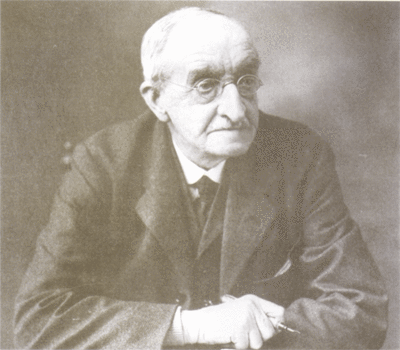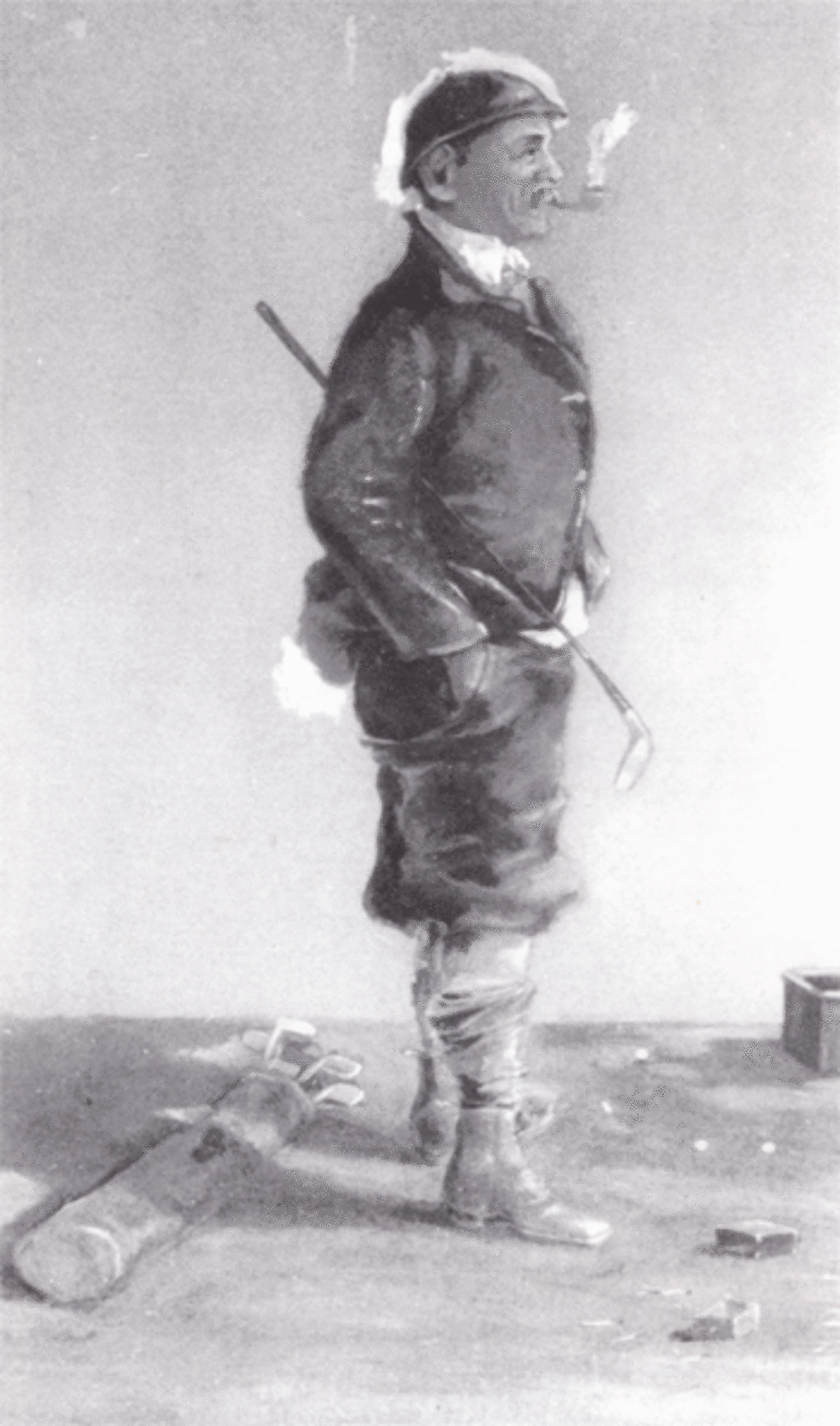First Members
Undoubtedly, the front man at the creation of the Trentham Club was the Rev Edmund Vincent Pigott, Rural Dean of Trentham,credited with being Club President from 1895 until he left the parish in 1908. Golfing vicars were far from unusual; the Venerable Archdeacon Maude was the first recorded President of Leek Golf club up to 1897 and the Rev CH Cole-Webb was most prominent in the creation of the South Staffordshire Golf Club in 1892. Whether Pigott was the prime mover at Trentham is another matter, however. He had six daughters, the eldest Katherine Gwendoline only two years younger than Duchess Millicent. It was probably this young lady who was reported to The Golfing Annual as Secretary of the Ladies' Section in 1896 when twenty six years old. If Trentham originated as a Ladies' Club involving the Duchess in some way, her most likely chief supporter would have been the daughter of the parish clergyman. Equally, when it came to admitting men and establishing a formal organisation, what more natural than the vicar taking the chair and the Duke acting as patron?

Trentham had enormous attraction for Potteries industrialists and professional people. Social distinction was acquired by association with the estate, the Duke, and especially Duchess Millicent. Arnold Bennett in his novel The Card illustrated the point beautifully when Denry Machin manipulated the invitations to the Countess of Chell's ball so as to acquire one himself. Golfers wanting to outscore Burslem could do no better than gain access to links laid out on Trentham Ley. Without further evidence at this stage it is speculation as to whether the Rev. Pigott founded a Club with the encouragement of the Duke for the entertainment of a few village friends, which was rapidly taken over by industrialists and doctors from the conurbation, or whether those same incomers initiated the whole business and found Pigott a welcome intermediary. What is certain is that by 1897 the Duke was intent upon developing Trentham as a new housing area for the industrial and professional elite of the Potteries, and advertised plots for building between the railway station and the police station for dwellings costing not less than £500. No doubt a golf club would have been considered a significant enhancement of local facilities.
The six committee members in 1896, the first Club members known, included three clergymen and their Secretary was senior partner in a firm of solicitors in Newcastle, Mr Joseph Guy Knight. Like his younger brother John, who was also a member, he was reputed to be a keen rider with the North Staffordshire Hunt at Trentham. One of them lived at Hartshill and the other at Aston, near Stone, and their addresses seem to have been confused by whoever sent in the entry for The Golfing Annual.
The players first reported in local papers included potters of distinction, and men with numerous other business interests. John William Hartley, for example, played in a monthly medal competition in May 1897 with Guy Knight and five others. Hartley was a Yorkshire engineer, and a very enthusiastic sportsman, who had come as chief locomotive draughtsman to the North Staffordshire Railway Co. in 1870. An engineering company he built up on his own account in Stoke-on-Trent was sold to Kerr, Stuart & Co. in 1892 and he then moved to Scotland. He returned in 1895 to manage his former works, and after the Boer War set up an independent business again with his son at Etruria, a company well known later as Simon Hartley Ltd. air engineer and inventor John Hartley was much respected in the pottery and railway, industries, and he advertised his genius on golf' courses throughout the county with his own carefully crafted universal club - presented long after his, death to the Club, but unfortunately now lost.
In November 1898 Hartley, was in the, team from Trentham which went to Burslem, along with D H Brownfield and Bernard Moore. Douglas Brownfield, eleven years younger than Hartley, has been described as "the greatest all round sportsman in the Potteries in the later Victorian period". He had played cricket for Trentham and England - against Australia in 1890; he was a reserve for an England rugby team, and had a local reputation as air outstanding track athlete. He was the son of' a Hanley pottery manufacturer, and ran the milling side of the firm from 1886. His home in 1891 was close to the railway station at Trentham, but he moved out to Leigh near Tean before 1899. In 1903 he was Captain of the Club and a member until his death in August 1917.
Bernard Moore the first Club captain, was the potter par excellence, however. He was forty eight when he was first noted locally, as a player at Trentham. Son of a Longton pottery manufacturer he was fascinated by the chemistry of glazes and ran the family business with his brother specialising in reproductions of ware with a high quality Chinese glaze known as sang-de-boeuf. When he died in 1935 he was called the greatest potter of' his age in the local Press. He lived at Draycott-in-the-Moors and his wife was a Trentham player before 1906 Bernard Moore was on the first known management committee in 1896, Captain from 1895 to 1901 a Trustee until July 1914. He was no mean golfer, for he established the first amateur record for the nine hole course on 31 October 1896 at 40, and was frequently noted in teams and competitions thereafter.
Moore's association in business with Doulton's, especially with their Burslem manager and director, John Cuthbert Bailey, is one of the pointers to Trentham Golf Club being from its inception a focus for potters from the whole of the district, but perhaps more particularly the southern half. By no means all the links between early members can be traced, but that between Bernard Moore and J C Bailey, or more strictly Bailey's son, Bernard Cuthbert, exemplifies the way business and pleasures were mixed at Trentham. Technical problems in the large scale production of rouge flambe more than likely occupied conversations just as much as stroke Play when the Baileys and the Moores were out on the greens.

J C Bailey was Club captain in 1905 and President in 1913. His reputation extended far beyond Doulton's and it was possibly respected within the Club more for his generosity and managerial acumen than for his golf. He became chairman of' the Staffordshire Potteries Manufacturers' Association and before 1894 lived at Bradwell Lodge. Later it moved to New Park, Trentham, one of the Duke's properties. Here it enjoyed his principal hobby of farming, though he was always thought of chiefly as a potter. "The biggest man in the Potteries it local reporter called him in the week of his death in 1929, "of towering stature, his men were dwarfed by his side. 'Big Bailey' he was known amongst Doulton's work people his name will stand out in bold relief as that of one who played it very notable part in the development of the pottery industry in its most artistic phase."
Bailey's predecessor at New Park, Edward Challinor, was a solicitor in Cheapside, Hartley, and the second Honorary Secretary to the Club. After about seven years he gave this up, married and went to live in North Wales, where he died in 1913. It was his brother, Arthur who had failed to turn up at one of the inaugural meetings of the North Staffordshire Club in Burslem in 1894. The Challinors were probably not very active as players and did not have wives and daughters as members. Daughters of John Knight, John C Bailey and Douglas Brownfield seem to have been among the ladies of the Club by 1906 and the Rev Mr Piggot's daughter continued to ad as Secretary to the Ladies' Section for several years until one of the Misses Llewellyn took over. Magdalene or Madge as she was sometimes known, was the first to join, followed soon after by Constance They originally lived at Seabridge Hall with their brother Rupert, also a member, but had a short spell at Scholar Green. Their father, Arthur Llewellyn, was Secretary to the Staffordshire Pottery Manufacturers' Association and Clerk to Tunstall Urban District Council.
Judging from press reports, and the earliest Subscription Books to survive from 1899, numerous prominent industrial families had membership at Trentham before 1904 F H Wedgwood was the only subscriber from his family, but H G Kirkham, and his brother William who had a Stoke pottery firm noted for specialist hospital ware, F S Heath of Biddulph Grange and R W Heath of Greenway Bank who came from the family of iron masters, Harold Twyford and his social reforming sister Dora who lived at Whitmore Hall and were of the family of sanitary ware manufacturers in Shelton, and F J and W B Moore who were partners operating the Cauldon Pottery Works, also in Shelton, were all listed as members. Landed gentlemen who subscribed, as well as the Duke of Sutherland included Basil Fitzherbert of Swynnerton and Ralph Sneyd of' Keele Hall, at which place another of Trentham's early members, His Imperial Highness Grand Duke Michael of Russia, was to reside.
At least one of the numerous clergymen came to the Club with a reputation for controversy. The Hon. Reverend Leonard F Tyrwhitt, Vicar of Fenton and chaplain-in-ordinary to Edward VII stirred a fierce battle of words in 1903 his "Devil in the Potteries" sermons. He lambasted the locals for the looseness of their morals and attracted much criticism for his pains. He probably didn't actually play much golf, for he went to India with the Prince of Wales in 1905 and left the district altogether ill 1907. Physicians', surgeons, Frederick Harrison the Headmaster of Newcastle-Under-Lyme High School, John Shields the dental surgeon ill Newcastle's Ironmarket, and several lawyers - plus wives and daughters are easily identified as members by 1904 In all, there were 80 men by 1896 and 136 in 1905 and as the total amount they paid in subscriptions is in the annual accounts from 1899 some overall assessment of the state of the Club at the end of its first ten years of existence can be made.


